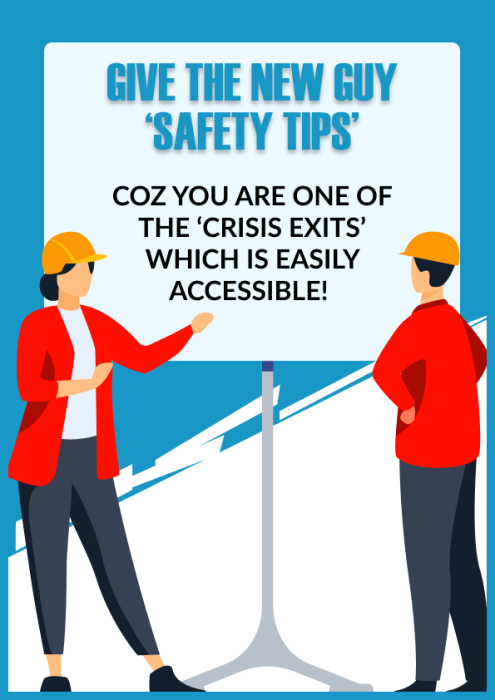Safety conversations – A Day in the life of an EHS site Manager

Even though each EHS professional’s day-to-day life is unique, shared characteristics are easy to find.
Some are amusing, some are frustrating, but they are all eerily familiar.
And what is that ‘one’ thing that sets them apart?
With an increasing emphasis on high standards in EHS management, as well as the critical operational aspects, there’s a need for a systematic approach to identifying hazards, assessing risks and their management at work.
The manner and extent to which these standards and elements are applied get determined by factors such as the organizational size, their primary nature of activities, along with their hazards and the conditions under which they operate.
Everything stands incomplete without a crucial involvement of an EHS professional!
More to discuss the important and vital role that they play in an industry, here we are!
The statistics below can sense the gravity of the commonly seen safety situations in our country!
- 72% of employees were oblivious to their company’s EHS function.
- 43% of employees would like to be able to provide feedback to their EHS team.
- Almost half of employees are concerned about a company’s water and energy conservation efforts, access to recycling, and whether the company takes its environmental impact seriously.
- 45% of employees are hesitant to report potentially dangerous behaviours to their co-workers or supervisors.
For each site, a site EHS manager is a responsible person who is a mandate, who thinks on an employee’s train of thought.
He/she edges through the observations captured for the benefit of the employees. The primary purpose sticks around as anticipating and preventing circumstances that could hamper a worker’s physical, mental, and emotional health.

The effectiveness of a great health and safety programme is dependent on good communication between managers and their employees on the one hand, and EHS managers and all operational staff on the other.
Getting out on the field and exchanging ideas with the operational staff is the best feedback an EHS manager can get to improve safety procedures.
These discussions will have a significant impact on workplace safety and health, especially when EHS managers put themselves in the shoes of the workers!
Building trust on safety conversations
Trust forms the basis of a discussion.
A safety manager should extend a vibe that’s more giving and comforting to the workers who approach them.
The more it happens, the more open they will be to all safety topics.
Safety animation can play a part in training.
During a tea break, or probably taking a walk-around tour with the employees, as well as other types of conversation approaches can be beneficial. One thing is certain: you will need to build trust to engage all employees in your approach!
You must be eager to plan events in which everyone, regardless of their daily tasks or professional background, feels personally involved. You must be careful to refrain from categorizing your conversations, as raising awareness of everyone’s struggles is also crucial.
The ideal situation is to put yourself in their shoes and work under the same conditions that they do every day. As a result, the safety and security discussions will be more legitimate, with a better understanding of the actual working conditions.
If, on the other hand, one is detached from the tasks at hand, the people around will believe that their reality is a thousand miles away from yours.
What to cover in safety, and what not!
A safety professional should carefully listen to and devote time to the safety feedbacks they receive, no matter how frequent or rare they are.
They serve as a springboard for topics that a team can ponder over the safety discussions that happen on intervals. They can also be excellent sources for all the technical and organisational information.
The difference between what’s happening in the field and what is written in the procedures can sometimes be important.
Books can teach us theoretical; a real learning happens on the field. One gets aware about the happenstances once a particular standard is executed, pros and cons can be effectively analysed.
So, things aren’t as clear as you think. Before the scheduled conversation, the best way to learn about the safety conversation topics is to consult with the appropriate personnel.
The conversation will be more accurate and relevant to the situation at hand as a result. Simply by virtue of your presence, the audience remains more attentive and receptive to ideas brainstormed during the sessions and gladly provides their inputs.
Possessing systemic thinking and communication skills
EHS Managers work with highly scientific methodologies. It takes skill to translate technical language into understandable conversations.
EHS Managers typically have the freedom to move around. You’re at the warehouse one day and the corporate office the next.
One thing is certain: EHS Managers do not work at a desk all day. Successful EHS Managers understand operational risk, which includes speaking with workers on the ground.
A walkthrough is more than just reminding employees to wear their PPE; it is also an opportunity to communicate with the workers you protect.
Surprisingly, most especially in the production would prefer to speak with you personally person rather than call you.
Science aids in the understanding of human factors in safety. Human factors influence workplace behaviour, so EHS Managers must investigate them as a risk prevention tool. To put it another way, EHS Managers must empathise to understand risk.
Furthermore, there has been discussion about whether EHS professionals should be responsible for workplace mental health. It’s a contentious issue, but one that necessitates soft skills.
A fun fact!
Did someone say Hierarchy of Controls? Wasn’t it the Heinrich Pyramid? Pyramids depicting various processes abound in EHS management.
A safety professional deal with all of them, daily!
We challenge you to count the number of EHS-related pyramids you’ve seen. And we’re guessing you might have never seen these many in Egypt! :)


